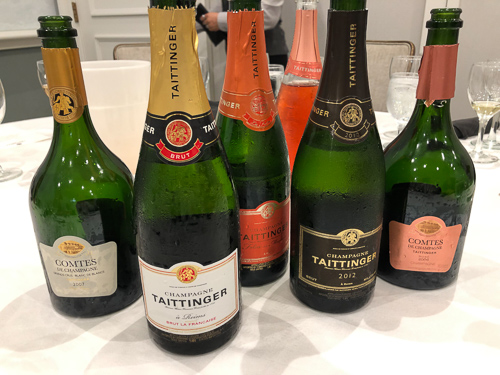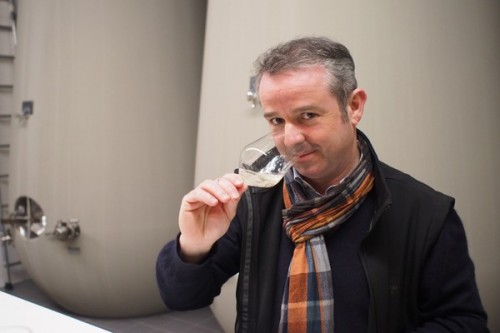
Day three began with a brilliant visit with the engaging, smart Rodolphe Péters (above) of Champagne Pierre Peters. He explained that there are three critical elements for him in making his Champagnes: terroir, pressing and reserve wines.
He begins with terroir. He’s not organic or biodynamic, largely because he has 20 hectares spread across 72 parcels, and it makes no sense, says Rodolphe, to try to be biodynamic with such small parcels. He does work organically in his two largest parcels, and with consulting clients where the vineyards are usually much bigger blocks.
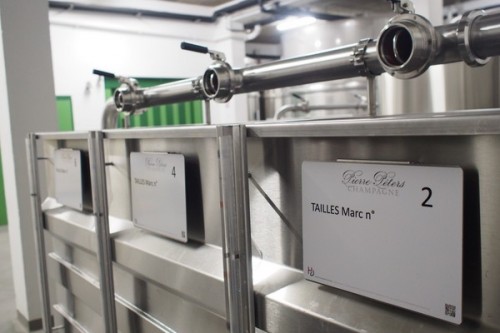
Nineteen hectares of these 20 are Chardonnay, with 16 in Grand Crus. There’s also a hectare of Pinot Noir in the Aube which he sells. He also sells grapes from half a hectare of young Chardonnay vineyards, so this means that his wines come from 18.5 hectares.
He says the harvest is a key moment, and with climate change it’s becoming harder to choose the right time to pick. It’s for this reason he has double the pressing capacity he needs, so that he can pick exactly when he wants. Farming is 80% of quality, he estimates.
Rodolphe is very careful about pressing. His approach is to pick perhaps 15% more grapes than he needs and then press less. This gives naturally clear juice, and because there’s no need for clarification with pectin or enzymes, nothing is lost, and he doesn’t have to add too much sulphur dioxide.
The wines are not racked and so they are kept on gros lees. He says his aim is to build his wines not on high acid but on three strands of bitterness: chalk/salt/iodine/marine, then citrus pith, and then fresh dried nuts (almond/hazelnut), which comes from the gross lees.
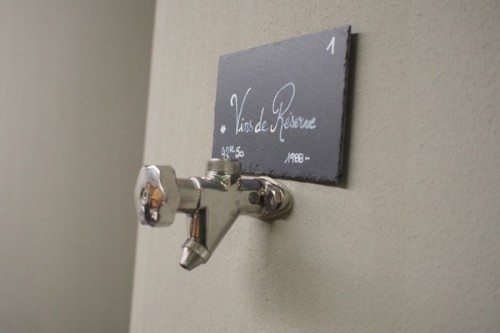
The reserve wines here are vary interesting, with a perpetual reserve. In 1997 he suggested to his father that they blend all the reserve wines together and then use it all, keeping a part of the non-vintage blend as a reserve for the next year. This is repeated each year, and the non vintage blend is half the current year plus half the reserve. The reserve wine is also stored in three kinds of vats: steel, concrete and casks, which adds complexity (we tried all three: concrete was the most mineral and interesting).
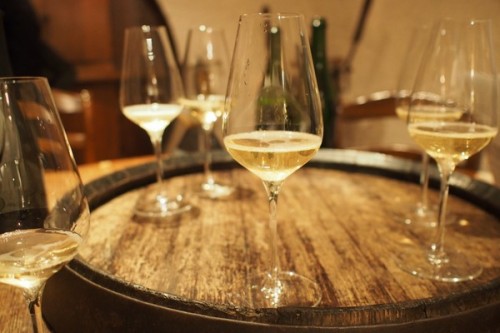
The wines? They’re excellent. We tried the NV with both the 2012 base and the 2013 (both lovely but the 2013 is exceptional), and then two vintages: the 2010 L’Esprit and the 2008 Chétillons. Both are truly wonderful, with a slight preference of mine for the latter, which is profound. Then we tried two special wines, the Reserve Oublié, which is the perpetual reserve from 2010 bottled in 2012, and the L’Etonnant Monsieur Victor Edition Mk 09. Both are really interesting, with elegance but also plenty of flavour.

Second visit was another brilliant one, with the dramatic, expressive Olivier Collin (above) of Ulysse Collin. He’s based in Congy, which is in the Coteaux du Sézanne, a little to the southwest of the Côte des Blancs. He got back his family’s vines from a large house back in 2003, and since 2004 has been making interesting terroir-driven wines of real intensity and depth.
Olivier had studied law for eight years before turning to winegrowing, and he completed a three month internship with Anselme Selosse before setting out on his own. As with Anselme, everything at Ulysse Collin goes through barrel. We looked at the 2015 wines from barrel, and then at some of the reserve wines. The approach here is one of working with discrete parcels and then seeking to express these terroirs.
Olivier tried working with organics in Les Enfers and Les Roises, and lost 100 and 70% of the crop in each during the 2012 growing season. So he’s abandoned that project. The most important thing is to plough, he says. After that, the protection of the leaves is your choice. He says that he now prefers to work the culture of the vines with his brain and the winemaking with his sensitivity. He works his way through the barrels from the current vintage and decides at the last moment what he will keep and what he will bottle.
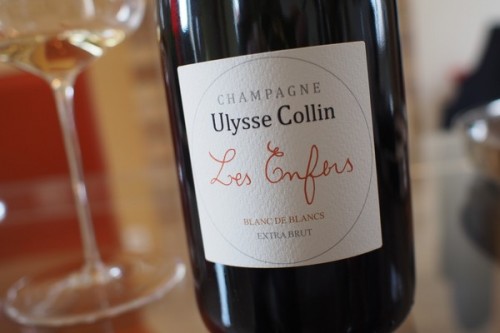
Olivier makes five wines from four sites. He makes the wines with ageing in mind, and suggests that his wines have the potential to develop for a decade, although with such a short track record he says he can’t be sure. They have so much personality: I really like them. They all have low dosage, with a maximum of 2.4 g/litre.
Les Perrières Blanc de Blancs is powerful, precise and detailed with lovely acidity. Les Maillons is a Pinot Noir with a remarkable fruity personality, bursting with lemons, cherries and rose aromas. Les Enfers is a Blanc de Blancs with an amazing complexity, and was my pick of a very fine bunch. Les Roises Blanc de Blancs is also fabulous with intense toast, almond, honey and citrus notes. The outlier is the distinctive sappy Rosé de Saignée Les Maillons, with its intense fruitiness and fairly deep colour. This is a Champagne grower to watch.
Leave a Comment on In Champagne, day 3 (part 1): Pierre Peters and Ulysse Collin